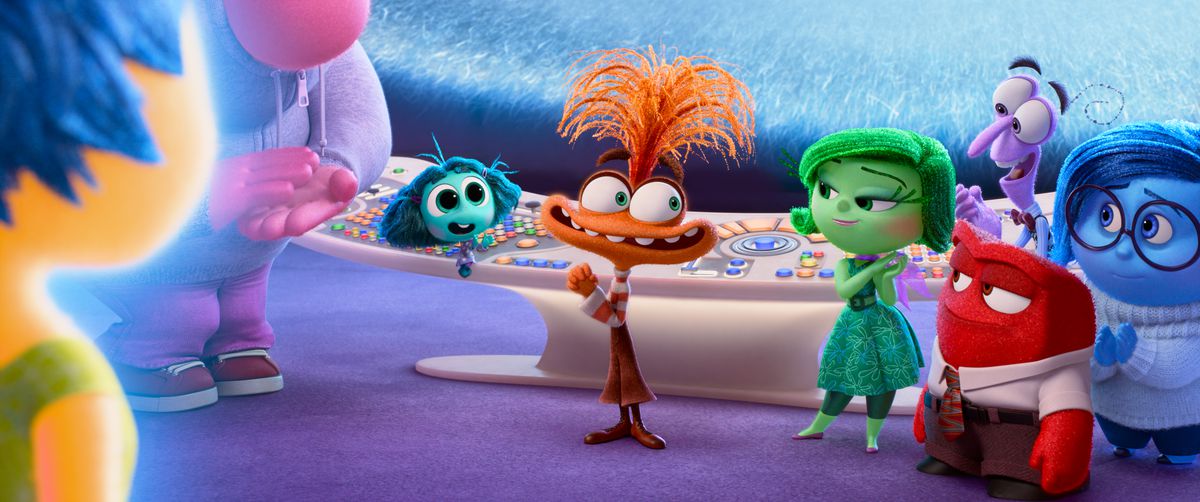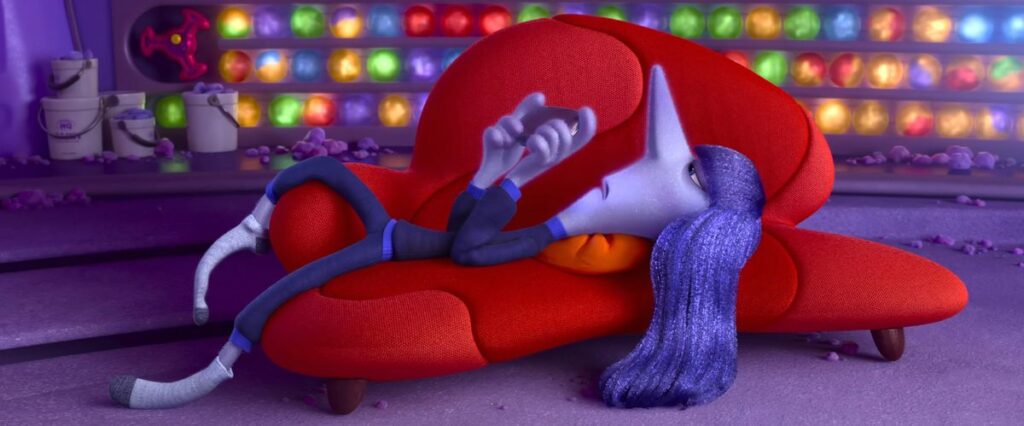Inside Out 2 is taking the sluggish 2024 box office by storm, having made more than $1.2 billion dollars worldwide in just a few weeks of release. This kind of major financial success generally only comes to “four-quadrant movies,” films that appeal to the four major box office demos: men and women, both above and under age 25. While Pixar Animation Studios’ latest does fit that bill, I came out of the theater firmly convinced that, while this film is relatable and enjoyable for most kids of most ages, it hits even harder if you’re an adult.
I took my 7-year-old niece to Inside Out 2, and she loved it. A media-literate gremlin who spends much of her free time robbing fictional banks in Roblox’s Brookhaven, rewatching Pixar’s Turning Red, or mesmerized by YouTubers unboxing their latest Pop Mart hauls, she knows how to dissect a fictional narrative, even if she doesn’t fully realize that yet. She chose Ennui (Adèle Exarchopoulos) as her favorite character in Inside Out 2, and she laughed at many of the movie’s jokes. She related to a lot of the interpersonal drama hitting Riley, the now-13-year-old girl at the center of the movie: My niece just started school last year, so, like Riley, she’s going through a lot of social changes. And she has a teenage brother, so it was helpful to see a straightforward depiction of how becoming a teenager can affect someone’s emotional landscape.
Image: Pixar Animation Studios/Everett Collection
Like many kids I know, my niece is desperate for information that might help her understand the world adults live in. She plays Brookhaven as a way to cosplay adulthood, decorating her house and driving around town in a limo, unbound by realities like financial stress or a full-time job. I think this quest for knowledge about adulthood is driven by a kind of anxiety that many contemporary kids feel, an unconscious belief that if she figures it all out before she turns 18, perhaps she will be able to avoid some of the struggles she recognizes in the adults around her. For her, Inside Out 2 was a hit, even if she doesn’t yet fully understand why.
By comparison, I am 36 years old, firmly in adulthood and inching closer to Millennial middle age every day. I’ve lived with anxiety since I was a kid, so I was fascinated by Inside Out 2’s exploration of belief systems and how anxiety can hijack them as we grow. Pixar’s original 2015 Inside Out presents the character of Sadness (Phyllis Smith) as a possible villain, but gradually reveals why sadness is vital to a healthy inner world. Anxiety (Maya Hawke) gets similar treatment in Inside Out 2. In a flip-flop of Sadness’ arc, Anxiety is initially presented as the solution to all of Riley’s coming-of-age problems, but she’s eventually revealed as a false panacea.
When kept in balance with other emotions, anxiety can kickstart ambition, motivating us to achieve our goals, keeping us alert, and helping prepare us for potential threats. As Anxiety puts it in the movie, she’s just trying to protect Riley by helping her anticipate and counter threats to her self-esteem or social status. But in excess, anxiety can paralyze us and keep us from moving forward. It can undermine our senses of self-worth and personal agency. It can convince us that if we can just figure out how to control everything (an impossible task), we can be immune to suffering (an impossible goal).

Image: Pixar Animation Studios/Everett Collection
As an adult who has found some perspective through EMDR therapy, I understand exactly what Inside Out 2’s creators are trying to communicate when they depict human value systems as simultaneously malleable and profound. I know what it is to falsely believe I can no longer access joy, and what it feels like to replace that negative belief with a more positive one. I’ve seen many adults on social media commenting on how hard the following line of dialogue hits: “Maybe that’s what happens as you grow up: You feel less joy.”
That line is central to the movie’s theme and its catharsis. And it can certainly hit hard for kids — especially kids who are understandably worried about the fear, confusion, and unhappiness they see in the adults around them. But I think it’s geared more toward adult viewers. For kids — and the character of Joy (Amy Poehler), who has only ever lived inside Riley — it is truly a question: “Will I lose joy as I age?” Adults are more likely to already have an answer to this question, and a strong emotional reaction to seeing it reflected back at them in Inside Out 2.
The movie eventually takes a definitive stance on that question, and offers an answer to kids and adults alike. In the climax of the film, Anxiety spins out, pushing Riley into a panic attack. She has to relinquish control of Riley’s internal landscape before Riley can feel emotions like Joy, Sadness, and Anger (Lewis Black) again. It’s only once Anxiety lets go that Riley is able to take responsibility for her actions, and start to feel better about herself. It’s only after Anxiety is given a supporting role rather than a starring one that the movie tells us we don’t have to lose joy on the path to adulthood — even if that’s a lie we adults sometimes tell ourselves in the effort to get through seemingly endless to-do lists and working weeks. And it’s a message adults need to hear even more than kids do.

Image: Disney/Pixar
In this age of misinformation and endless distraction, there’s something to be said for movies that communicate themes simply and earnestly, with less space for misinterpretation — movies like Inside Out 2 and 2023’s biggest global hit, Barbie. There is so much room in online and media conversation right now for people who misconstrue ideas, both intentionally and unintentionally. It’s often encouraged, even, thanks to the popularity of the ever-frothing outrage culture machine. I think movies like Inside Out 2 and Barbie hit harder, especially for adults, because they attempt to communicate vital ideas directly, with as little room for misinterpretation as possible.
Kids are used to this in their media, but adults aren’t. That helps explain why so many adults latched onto America Ferrera’s extremely straightforward Barbie monologue about contradictory standards for women as a discussion topic. I think the same is true for many of the ideas explored in Inside Out 2. Just because we’re adults doesn’t mean we don’t need things explained to us, or that words of comfort aren’t meant for us.
There’s this idea in American culture that once we reach adulthood, we should be able to weather cruelty and hardship without complaint, comfort, or catharsis without feeling. But why would that be true? Leaving childhood just makes our emotions more complex, and better at tricking us if we don’t have the space or tools to understand them. Our emotions can be just as powerful as childhood emotions, but now, they’re coupled with the power adulthood can grant us to hurt ourselves and others.
If anything, that makes movies like Inside Out 2 — movies that demonstrate the necessity of recognizing the control emotions can have over us — much more important for adults. Adults are so rarely encouraged to feel, express, and process their emotions the way children are. This especially leaves behind the adults who weren’t given that chance as children. Inside Out 2 offers a small opportunity for adults to better understand our own emotions, especially the role Anxiety can play in our lives. And it does so by slipping its messages to us in the guise of a movie made for kids. What a vital gift that is for our culture, and for everyone still working on coming to terms with their own anxieties, at any age.

